Last Thursday we finally worked the return ride to the pagoda at Beichangshediancun into our schedules. Our student “Blake” and colleague “Justin” joined us for an early start. We needed to be back for a library dedication ceremony. Steve was to be honored for being instrumental in getting 20,000 books donated to the University.
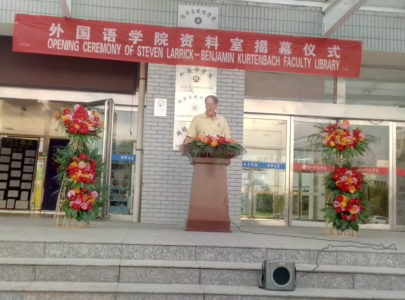 I need to get my helmet cam working again because the early trip out of town was otherworldly. If I thought the old riverside park was busy in the evening, it was nothing compared to early morning. Not one more group excercise activity could have fit. Cheek to jowl were positioned: “square dancing,” (the ever-popular group exercise activity for mostly older women) tai chi, yoga, chi gong, a group dance performed with rackets and balls, walking groups, and even a large chorus. Some of these were repeated along the path. I also often see ballroom dance groups and whip crackers. I’d love to see outdoor spaces in the U.S. used more for these kinds of activities on an ongoing basis. It’s how people socialize, along with the “adult playgrounds.” In the afternoon, Chinese chess, mahjong, and poker take over the park, attracting crowds, along with a sprinkling of vendors and fortune tellers. There are even some barbers. A little further down is the territory of the Chinese Opera performers, who pack in mostly retired onlookers. These groups don’t seem to have spread yet to the more spacious new riverside park. I think many of the participants live in the old neighborhood alongside this park, and the old village next to the new park was demolished. People would need to travel further to get there.
I need to get my helmet cam working again because the early trip out of town was otherworldly. If I thought the old riverside park was busy in the evening, it was nothing compared to early morning. Not one more group excercise activity could have fit. Cheek to jowl were positioned: “square dancing,” (the ever-popular group exercise activity for mostly older women) tai chi, yoga, chi gong, a group dance performed with rackets and balls, walking groups, and even a large chorus. Some of these were repeated along the path. I also often see ballroom dance groups and whip crackers. I’d love to see outdoor spaces in the U.S. used more for these kinds of activities on an ongoing basis. It’s how people socialize, along with the “adult playgrounds.” In the afternoon, Chinese chess, mahjong, and poker take over the park, attracting crowds, along with a sprinkling of vendors and fortune tellers. There are even some barbers. A little further down is the territory of the Chinese Opera performers, who pack in mostly retired onlookers. These groups don’t seem to have spread yet to the more spacious new riverside park. I think many of the participants live in the old neighborhood alongside this park, and the old village next to the new park was demolished. People would need to travel further to get there.
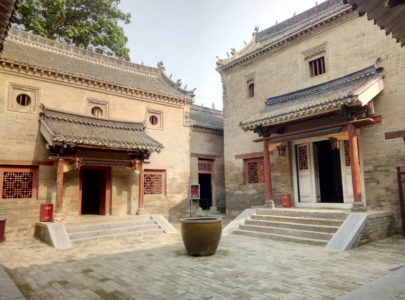 But I digress. The day was fine, the levee road was dry, and after about two hours we were in Dengcheng, where we found that the old Qing dynasty manor house was finally partially re-opened after a lengthy restoration. After a tour and a stop for some tasty veggie baozi, a type of filled steamed bun, we were back on the trail. Several hours later we finally rolled up the the pagoda, much later than I had anticipated, to find it shrouded in netting and scaffolding. The restoration crew must have just moved on from the manor house to the pagoda.
But I digress. The day was fine, the levee road was dry, and after about two hours we were in Dengcheng, where we found that the old Qing dynasty manor house was finally partially re-opened after a lengthy restoration. After a tour and a stop for some tasty veggie baozi, a type of filled steamed bun, we were back on the trail. Several hours later we finally rolled up the the pagoda, much later than I had anticipated, to find it shrouded in netting and scaffolding. The restoration crew must have just moved on from the manor house to the pagoda.
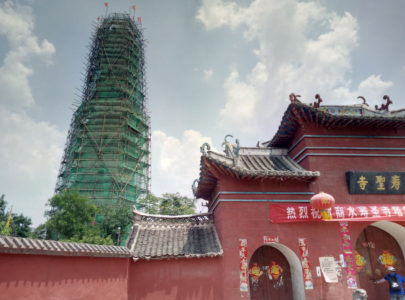 We had planned on lunch in Xiaoyaozhen on the other side of the river, but the river was too high for the tiny ferry to cross. After a delayed lunch in the village I was nervous about getting back in time for the ceremony. I thought that I had allotted plenty of time for the ride but I had miscalculated the speed of our traveling companions. I wasn’t worried about them finishing the 75 mile roundtrip ride, but neither of them ride much distance. Feeling a little sheepish, I told them we needed to ride on ahead.
We had planned on lunch in Xiaoyaozhen on the other side of the river, but the river was too high for the tiny ferry to cross. After a delayed lunch in the village I was nervous about getting back in time for the ceremony. I thought that I had allotted plenty of time for the ride but I had miscalculated the speed of our traveling companions. I wasn’t worried about them finishing the 75 mile roundtrip ride, but neither of them ride much distance. Feeling a little sheepish, I told them we needed to ride on ahead.
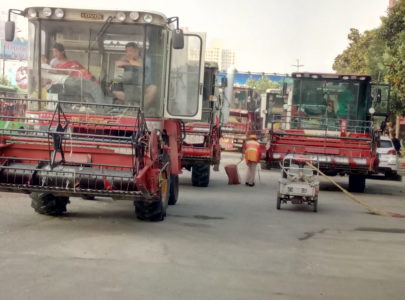 Steve and I took county roads back, past farmers taking a siesta on the roadway under the trees. Wheat harvest is in high gear. We met convoys of pint-sized combines moving from field to field, and some farmers with scythes doing it by hand. In about three hours we were back in Zhoukou. It was difficult to give instructions to our companions for the roads we took back, so they took the highway, including the bone-pounding S238. I did feel bad about that.
Steve and I took county roads back, past farmers taking a siesta on the roadway under the trees. Wheat harvest is in high gear. We met convoys of pint-sized combines moving from field to field, and some farmers with scythes doing it by hand. In about three hours we were back in Zhoukou. It was difficult to give instructions to our companions for the roads we took back, so they took the highway, including the bone-pounding S238. I did feel bad about that.
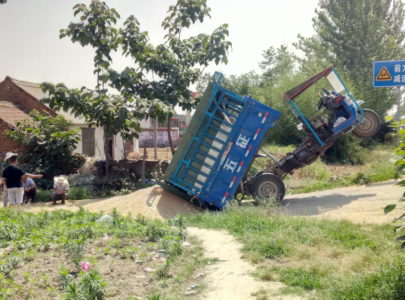 Sunday I hit the road early again, deciding to revisit Luohe. I thought I’d avoid the obvious road, the infamous S238, and take a different route. It seemed a good choice until I found myself on a section the equal of it. Luohe is about the same size as Zhoukou, and is the closest high speed rail access we have until September of 2019, when it is due to open here. After lunch and a sort-of coffee (I couldn’t find a Dicos) I was headed back on a new section of the S238, so smooth it was boring, but I knew it wouldn’t last.
Sunday I hit the road early again, deciding to revisit Luohe. I thought I’d avoid the obvious road, the infamous S238, and take a different route. It seemed a good choice until I found myself on a section the equal of it. Luohe is about the same size as Zhoukou, and is the closest high speed rail access we have until September of 2019, when it is due to open here. After lunch and a sort-of coffee (I couldn’t find a Dicos) I was headed back on a new section of the S238, so smooth it was boring, but I knew it wouldn’t last.
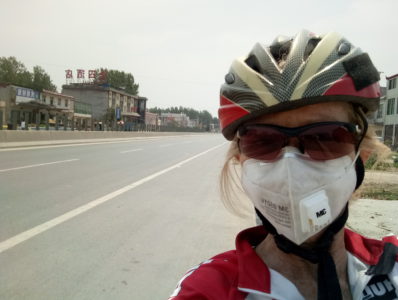 When it deteriorated I took the long way back on country roads to the levee just to avoid it. I’ve seen the abandoned weigh stations and I know road construction is endless. Priorities must be placed elsewhere. Using a bicycle though, I can go where I choose, and I had a good ride with some detours and new territiory explored.
When it deteriorated I took the long way back on country roads to the levee just to avoid it. I’ve seen the abandoned weigh stations and I know road construction is endless. Priorities must be placed elsewhere. Using a bicycle though, I can go where I choose, and I had a good ride with some detours and new territiory explored.
